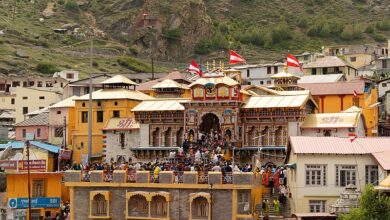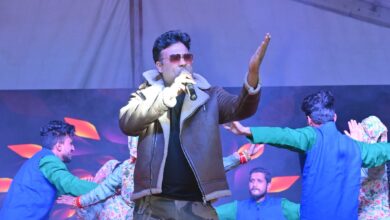Shravani Upakarma to start Vedapath

Narayali Purnima and Avani Avittam in South India on Shravan Purnima, Kajari Poonam in Central India, In North India it is celebrated as Raksha Bandhan and in Gujarat as Pavitropana. It is also called Shravani Upakarma (Upakramam). Undertaking means beginning, To start. From this day Yajurvedi Brahmins start the Yajurveda recitation for the next six months. This day is also important because according to mythological texts, Lord Vishnu incarnated as Hayagriva, the god of knowledge, on this day.
In ancient times, self-study of the only Vedas and Vedic literature was prevalent. People used to read and recite Vedic literature every day, but during the rainy season, the recitation of Vedas was specially organized. In India, the full moon day of Shukla Paksha of Shravan month, the fifth month of Vikrami Samvat, has been celebrated as Shravani festival since ancient times. Shravan Purnima is celebrated as Narayali Purnima and Avani Avittam in South India, Kajari Poonam in Central India, Raksha Bandhan in North India and Pavitopana in Gujarat. It is also called Shravani Upakarma (Upakramam). Undertaking means beginning, beginning. From this day Yajurvedi Brahmins start the Yajurveda recitation for the next six months. This day is also important because according to mythological texts, Lord Vishnu incarnated as Hayagriva, the god of knowledge, on this day. Tool means to invite or bring near to begin. In the Vedic period, it was the period for the students to gather near the Guru for the study of the Vedas.
According to the Smriti texts, when the vegetation is produced, the upakarma is performed on Shravan Panchami in the month of Shravan and the meeting of Moon (Purnima) or Hasta Nakshatra. This ritual is performed collectively on the day of Yajurvedi Rakshabandhan and Samvedi Bhadrapada Shukla Dooj at the ghat of the holy river. In fact, Upakarma is a Vedic ritual performed by Brahmins. This ritual is also performed by Kshatriya and Vaishya community. Because they are also dvijas, they have the right to perform sandhyavandanam, the daily bathing ritual. Upakarma is conducted once in a year. On the day of Shravan Purnima or in Dhanishta Nakshatra, Brahmins perform religious ceremonies and wear the Upanayana thread with Vedic mantras. The end of this study session is called excretion or excretion. This session lasts till Magha Shukla Pratipada or Paush Purnima. On the auspicious day of Shravan Shukla Purnima, along with Rakshabandhan, a holy coincidence of Shravani Upakarma is formed. Especially this holy day is very important for human beings.
It is noteworthy that the process of taking birth of a human being is considered to be a natural process of nature, but it is an enduring effort. Nutritious and nurtured – both have to make strong effort under this. That is why the saying is prevalent that human birth is achieved easily, but hard effort has to be made to develop humanity. In ancient times, students used to enter Gurukuls on Shravan Purnima. This day was specially celebrated as Vidyarambh Diwas. The sacrificial rites of Batukas were also performed. There has also been a tradition of wearing the new Yajnopaveet after taking off the old Yagyopaveet on the day of Shravani Purnima. In the Indian economy dependent on agriculture, the Ashadh-Shravan month is for sowing of crops.
In ancient times, sages used to come and live near the village due to the abundance of rain in the forest, and stayed in one place for four months of the rainy season. Which the villagers used to take advantage of, and used to discuss religion with them. Which is called Chaturmas or Chaumasa. Even today this tradition continues. In these four months, there was Veda study, religious updesh and knowledge discussion. Devotees and Vedabhyasis used to serve him and attained knowledge. This period was called Rishi Tarpan. The day from which the undertaking of Veda Parayan started is called Upakarma. This Vedic study was started from Shravan Sudi Purnima. Hence it is also called Shravani Upakarma. Paraskar Guhya Sutra 2/10/2-2 states that-
AthatoSdhyayopakarma. Aushadhanam Pradurbhave Shravanya Poornamasasyam. – Paraskar Secret Sutra 2/10/2-2
That is, the upakarma of the study of Vedas started from Shravani Purnima and lasted for four and a half months till the new moon of Paush month. This upakarma was emitted in Paush.
In this tradition, even today Chaturmas are organized by Hindu saints and Jain sages, and they give up their excursions and stay at one place for four months and give discourses and sermons. According to Manusmriti, Brahmins should study the Vedas diligently for four and a half months starting from Shravani and Paushtapadi Bhadrapada, Poornamasi tithi and emit this Upakarma in Paush month or on Magh Shukla Pratipada. During this period Vedadhyana was done daily, Sandhya and Agnihotra were performed every day. Wearing a new Yagyopaveet, a vow was taken not to bring laxity in self-study. By not self-studying the Vedas, the two castes become Shudras and by doing self-study, the Shudras also go to the rank of Brahmins. In this way Vedadi study and self-study had great importance in ancient times.
There are three benefits of Shravani festival, spiritual, scientific and social. The meaning of Shravan is – in which to be heard. The most important divine knowledge in the world is the Vedas. That is why the Vedas are recited in this month. After the summer in Shravan, due to the onset of rain, the mind becomes calm, due to the favorable environment, the mind becomes happy. Due to rain, man spends more and more time at his home. Such an occasion has been considered favorable for self-study, contemplation, contemplation and conduct of Vedas since ancient times. Man’s spiritual progress through self-study and conduct of Vedas is the spiritual purpose of the practice of Shravani festival. Due to the rains in Shravan, many diseases spread due to the increase in the outbreak of insects, moths to viruses, bacteria etc. In India, since ancient times, there has been a great tradition of curing diseases through Agnihotra. Special provision has been made for daily Agnihotra along with self-study of Vedas in the month of Shravan. That is why the Veda Parayan Yagya was included in it. This not only protects the Veda-pathic Brahmins who keep the Shruti tradition alive, but also increases the interest of the public towards the Vedas. The scientific side of Shravani festival is popular as environmental protection.
In the month of Shravan, the people who follow the Grihastha Ashram take advantage of leaving the forest and living in the nearby places of the city for their spiritual progress. Living according to the religion of the Mahatmas, Vedic knowledge, yoga advancement and experience are beneficial in guiding and managing the householders in life. The social aspect of Shravan festival is to guide the society and enrich the religious sentiments by knowledgeable human beings. In the course of time, being away from Vedic knowledge, the Indian public forgot it due to the promotion of foreign culture. And this festival got converted into Rakhi i.e. Raksha Bandhan. Women were in danger of outraging their modesty from Muslim terrorists, Yavanas. They used to kidnap forcibly.
To avoid this, the tradition of women tying a thread on their wrists by women to make them pledge to protect themselves. And the festival of Rakshabandhan also started being celebrated on Shravan Sudi Purnima. The meaning of ashes is to keep, preserve, protect. Any woman used to send Raksha Sutra (Rakhi) to any hero and make her Rakhi-bandh brother, he used to consider it his duty to protect him for life. Before this, the work of tying the thread of defense was done by the Dwij, Brahmin people. At present, due to the wide publicity of the bond of Raksha Sutra, the festival of Rakshabandhan is being celebrated in a big way.





